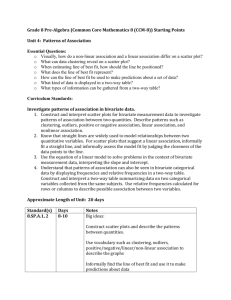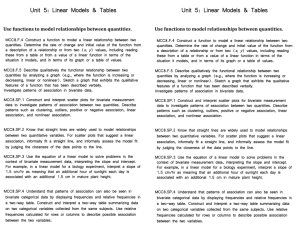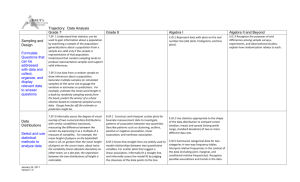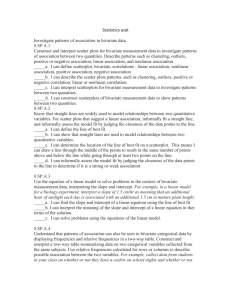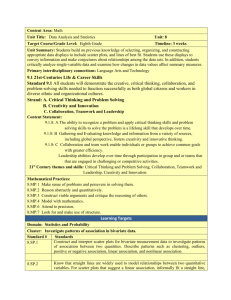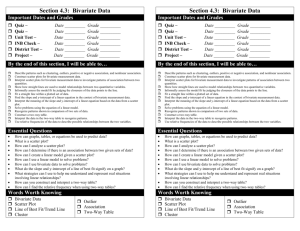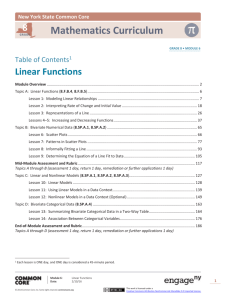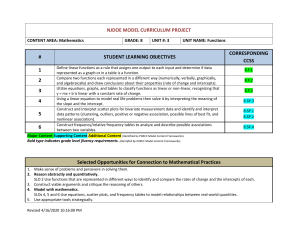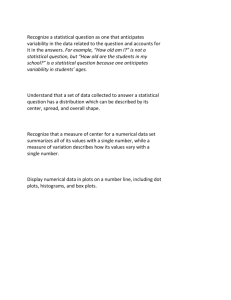WVU K12 Partnerships Unit Overview Construction Tool
advertisement
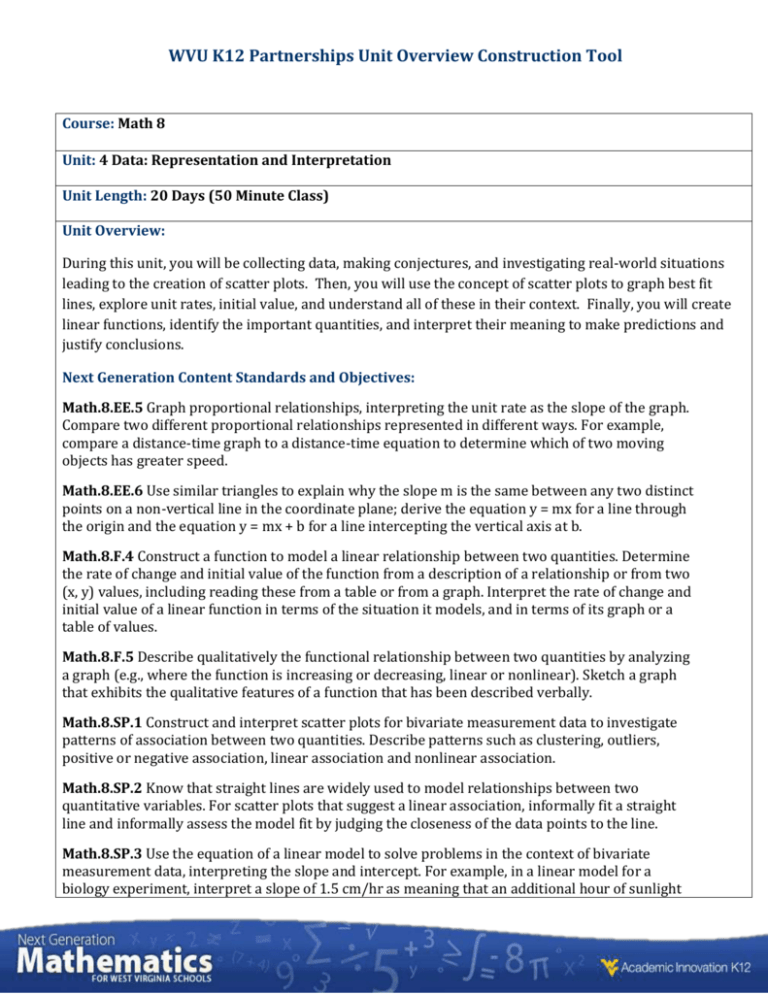
WVU K12 Partnerships Unit Overview Construction Tool Course: Math 8 Unit: 4 Data: Representation and Interpretation Unit Length: 20 Days (50 Minute Class) Unit Overview: During this unit, you will be collecting data, making conjectures, and investigating real-world situations leading to the creation of scatter plots. Then, you will use the concept of scatter plots to graph best fit lines, explore unit rates, initial value, and understand all of these in their context. Finally, you will create linear functions, identify the important quantities, and interpret their meaning to make predictions and justify conclusions. Next Generation Content Standards and Objectives: Math.8.EE.5 Graph proportional relationships, interpreting the unit rate as the slope of the graph. Compare two different proportional relationships represented in different ways. For example, compare a distance-time graph to a distance-time equation to determine which of two moving objects has greater speed. Math.8.EE.6 Use similar triangles to explain why the slope m is the same between any two distinct points on a non-vertical line in the coordinate plane; derive the equation y = mx for a line through the origin and the equation y = mx + b for a line intercepting the vertical axis at b. Math.8.F.4 Construct a function to model a linear relationship between two quantities. Determine the rate of change and initial value of the function from a description of a relationship or from two (x, y) values, including reading these from a table or from a graph. Interpret the rate of change and initial value of a linear function in terms of the situation it models, and in terms of its graph or a table of values. Math.8.F.5 Describe qualitatively the functional relationship between two quantities by analyzing a graph (e.g., where the function is increasing or decreasing, linear or nonlinear). Sketch a graph that exhibits the qualitative features of a function that has been described verbally. Math.8.SP.1 Construct and interpret scatter plots for bivariate measurement data to investigate patterns of association between two quantities. Describe patterns such as clustering, outliers, positive or negative association, linear association and nonlinear association. Math.8.SP.2 Know that straight lines are widely used to model relationships between two quantitative variables. For scatter plots that suggest a linear association, informally fit a straight line and informally assess the model fit by judging the closeness of the data points to the line. Math.8.SP.3 Use the equation of a linear model to solve problems in the context of bivariate measurement data, interpreting the slope and intercept. For example, in a linear model for a biology experiment, interpret a slope of 1.5 cm/hr as meaning that an additional hour of sunlight WVU K12 Partnerships Unit Overview Construction Tool each day is associated with an additional 1.5 cm in mature plant height. Math.8.SP.4 Understand that patterns of association can also be seen in bivariate categorical data by displaying frequencies and relative frequencies in a two-way table. Construct and interpret a two-way table summarizing data on two categorical variables collected from the same subjects. Use relative frequencies calculated for rows or columns to describe possible association between the two variables. Standards for Mathematical Practices: 1 Make sense of problems and persevere in solving them. 2 Reason abstractly and quantitatively. 3 Construct viable arguments and critique the reasoning of others. 4 Model with mathematics. 5 Use appropriate tools strategically. 6 Attend to precision. 7 Look for and make use of structure. 8 Look for and express regularity in repeated reasoning Driving question: 1. How can the same mathematical idea be represented in a different way? Why would that be useful? 2. How does collecting, modeling, and interpreting the relationship between two quantities help make sense of data? Overview script: Math 8 Unit 4 Overview Data: Representation and Interpretation Script Display WVU K12 Partnerships Unit Overview Construction Tool Math 8 Text: Unit 4 Overview ● ● Text Data: Representation and Interpretation Unit 4 is based upon 2 driving questions: How can the same mathematical idea be represented in a different way? Why would that be useful? How does collecting, modeling, and interpreting the relationship between two quantities help make sense of data? Math 8 Unit 4 Overview Data: Representation and Interpretation Text How can the same mathematical idea be represented in a different way? Why would that be useful? How does collecting, modeling, and interpreting the relationship between two quantities help make sense of data? Maybe Graphics of Equations, Tables, Linear Graphs and Survey Questions in the background In this unit you will build on the work you have already done with linear functions and relationships. Linear functions show a relationship between two variables. The points of a linear function lie along a straight line. A linear relationship is a relationship in which there is a constant rate of change between two variables; for each interval increase in one variable, there is a constant change in the other variable. For example: Joe wants to buy a video game that costs $60. He has $15 in savings. He earns $5 for shoveling snow off of each driveway. How many driveways must Joe clear in order to Please take full liberty in using your imagination WVU K12 Partnerships Unit Overview Construction Tool have enough money to buy the video game? Represent this problem situation using a table, graph and equation. Next, you will analyze non-linear graphs for different rates of change. You will use the context of the graph to explain the changes in variables. Bivariate is a fancy word for two variables. Chances are you have already worked with equations containing two variables like y=2x or y=3x + 4. Now you will use that knowledge to work with two variable data that has been collected. Two-way frequency tables and scatterplots are often used to organize data that is classified by two quantitative variables and can be used to explore if a relationship exists between the quantities. Need a graph (or animation) to display John walking to school. Need varying rates of change i.e. walking at steady pace, stopping at crosswalk, running, arriving at school. Distance vs. Time Graph. Something like this: http://www.mathwarehouse.com/classroom/worksheets/distancevs-time/distance-vs-time-graph-worksheet.pdf Absences Math Scores 3 65 5 50 1 95 1 90 3 80 6 40 5 70 3 75 0 100 Have this chart and a scatter plot of the data. Animate a line of best fit being drawn through the scatter plot 8th Grade Students Patterns of association can also be seen in categorical data that is displayed in a twoway table. Relative frequencies calculated Male Female Total WVU K12 Partnerships Unit Overview Construction Tool for rows or columns may be used to describe possible links between two variables. Why do I have to learn this? When am I ever going to use this in real life? To be well equipped for the career options of your future, understanding that the way information is collected and represented can be critical to your ability to make reasonable decisions. These skills will help you in the field of Marketing, Finance, Hospitality and Tourism, Health, and Forestry/Natural Resources. The key performance tasks for this unit are to: Make conjectures Collect data and interpret meaning to justify conclusions Investigate real-world situations Identify important quantities Make Scatter plots Determine the line of best fit Construct Two-way tables for quantitative and categorical data Understand unit rates and how they relate to slope Convert information from a table, graph, and equation The students will know: Extracurricular Activities 23 20 43 No Extracurricular Activities 12 25 37 Total 35 45 80 Pictures that relate to each of the listed careers. The key performance tasks for this unit are to: Make conjectures Collect data and interpret meaning to justify conclusions Investigate real-world situations Identify important quantities Make Scatter plots Determine the line of best fit Construct Two-way tables for quantitative and categorical data Understand unit rates and how they relate to slope Convert information from a table, graph, and equation WVU K12 Partnerships Unit Overview Construction Tool vocabulary as related to the context how to describe data relationships characteristics of linear equations The students will do: create two-way tables make scatter plots fit lines to data calculate slope/unit rate and initial value interpret linear equations in context of situation
